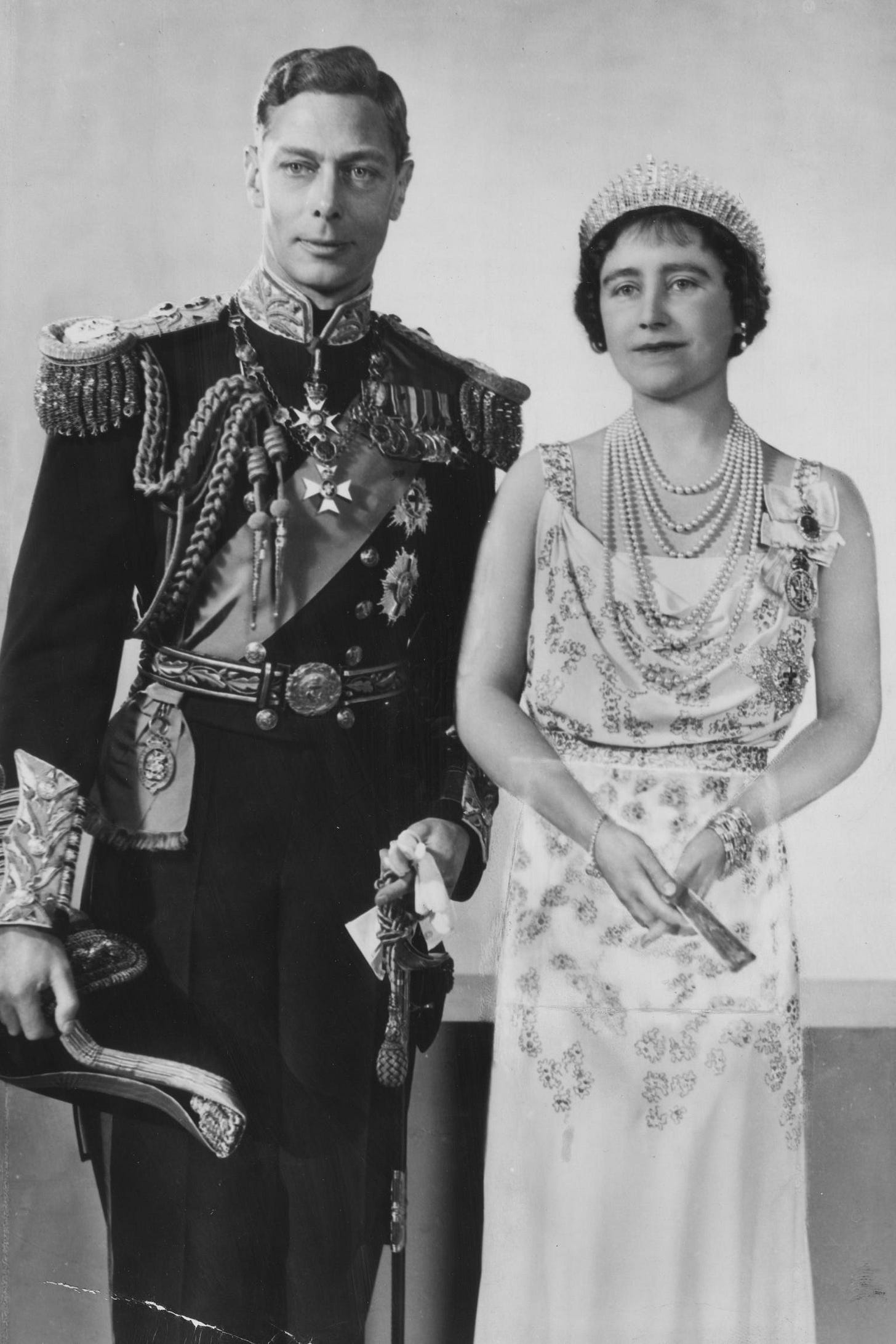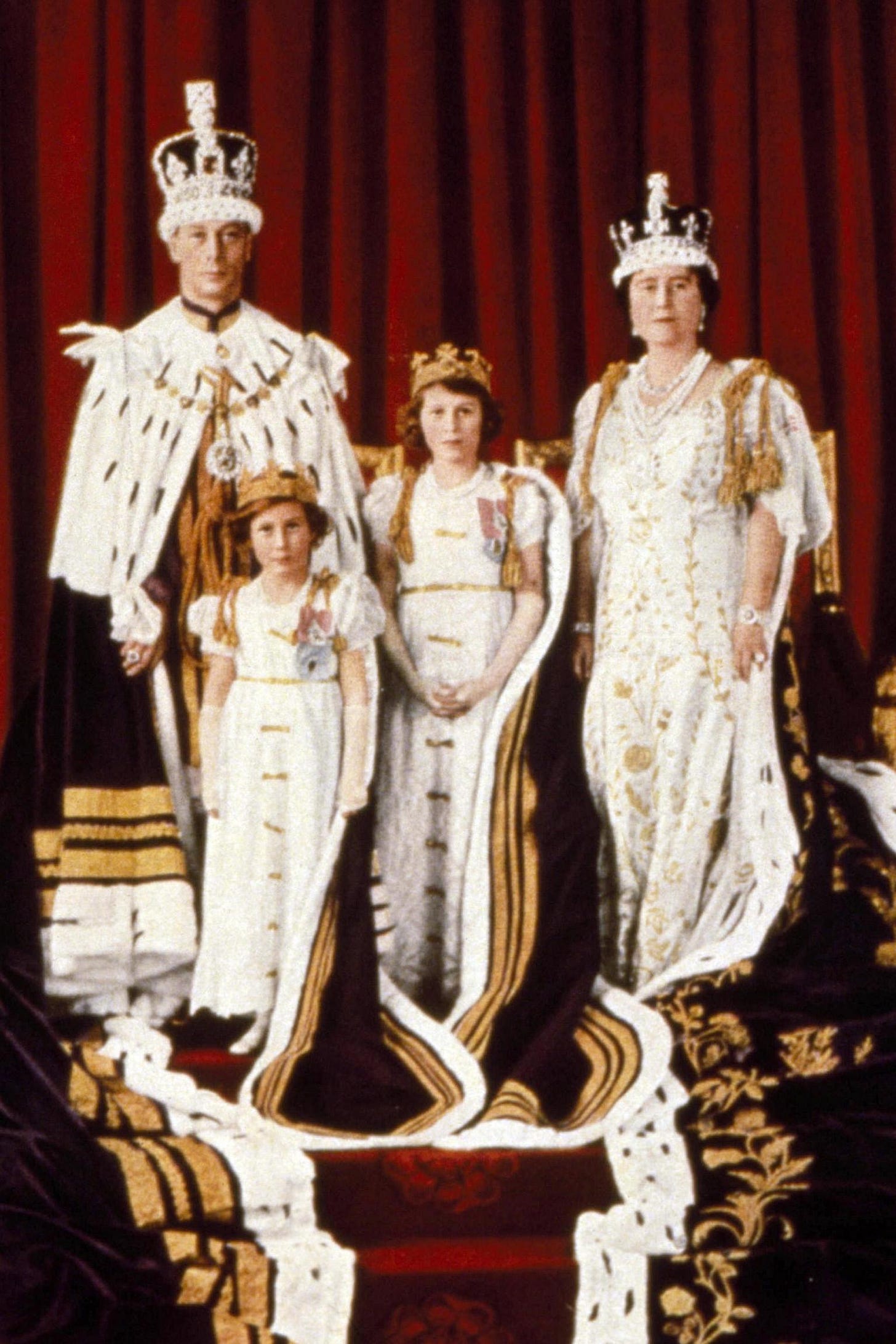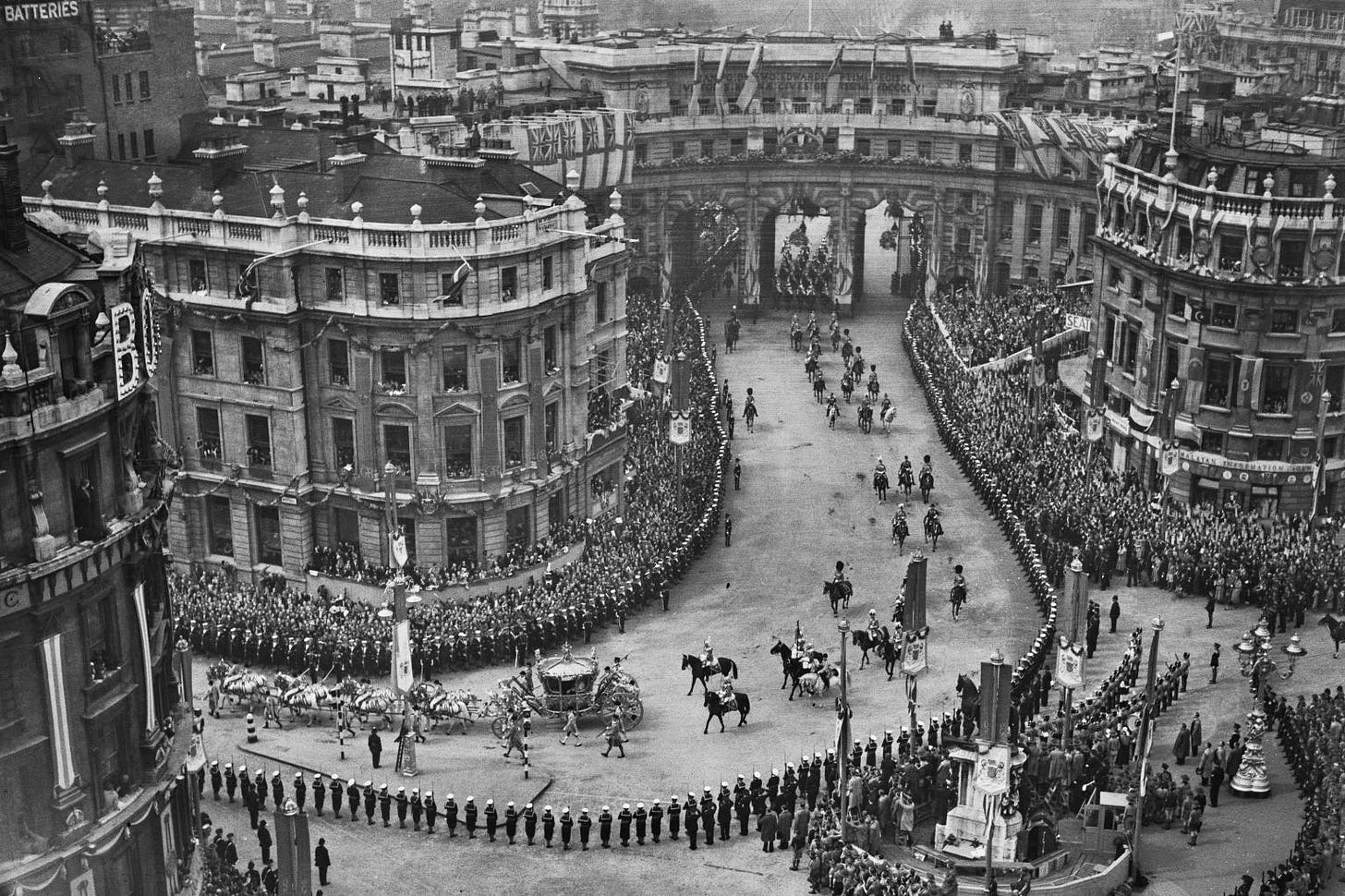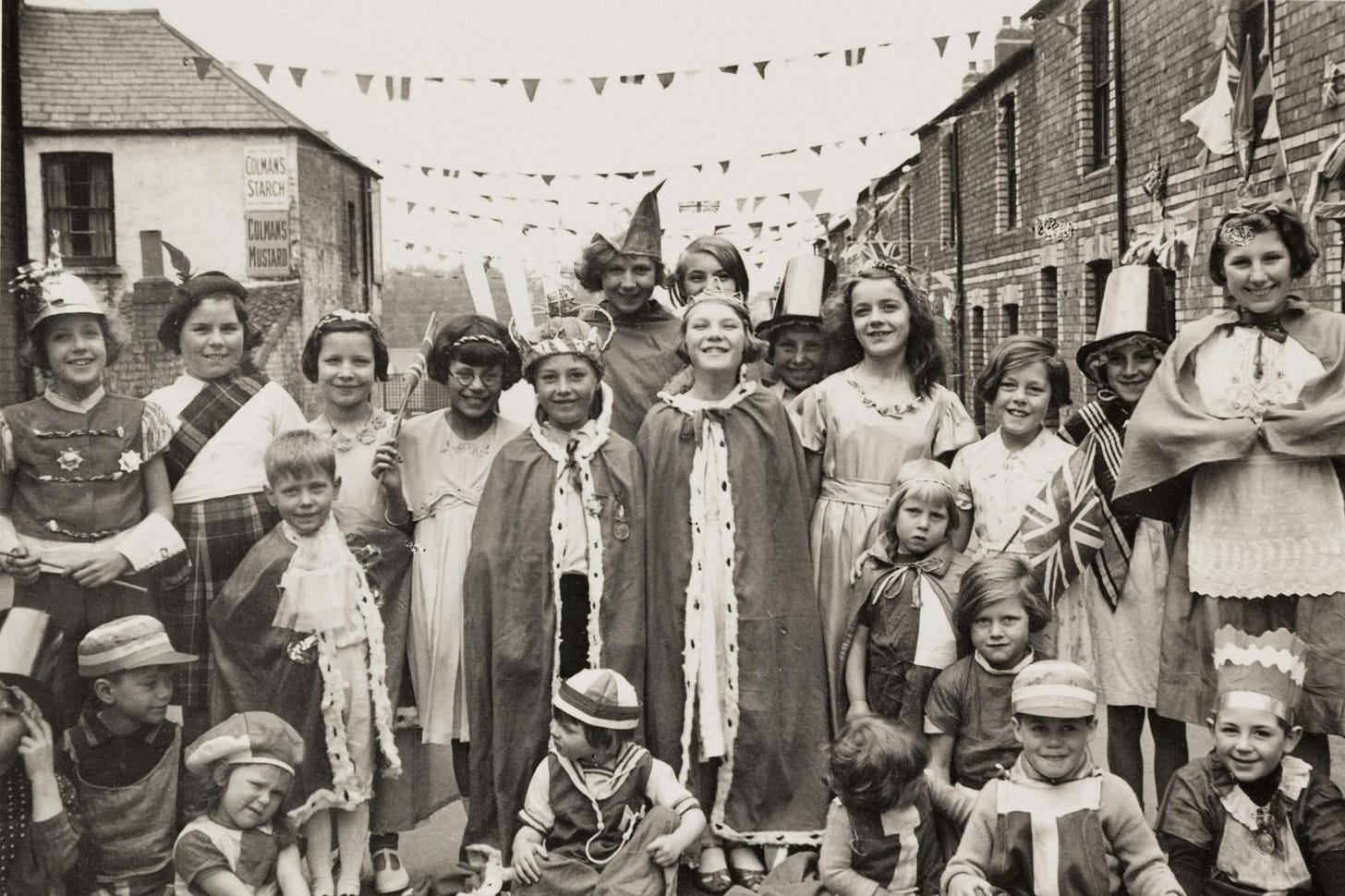The Times of London has a gorgeous extract today from George VI and Elizabeth: The Marriage That Saved the Monarchy
As we approach the coronation of King Charles III a month from today, the rituals and traditions of the coronation on May 12, 1937 of his grandfather, King George VI are shown in sharp relief
ROYAL FAMILY | BOOK EXTRACT
Was this the coronation that rescued the monarchy?
exclusive
The Windsors had a lot at stake when George VI was crowned, writes King Charles’s biographer Sally Bedell Smith
KEYSTONE-FRANCE/GAMMA-KEYSTONE VIA GETTY IMAGES
Sally Bedell Smith
Thursday April 06 2023, 12.01am BST, The Times
The main mission of 41-year-old Bertie and 36-year-old Elizabeth in their first year as king and queen was to rebuild the foundations of the monarchy badly battered by Edward VIII. The apex of that reconstruction would be the coronation on Wednesday, May 12, 1937. George VI had to show that he was capable of leading Britain and the empire as well as inspiring his subjects. That meant performing at a high level not only during the lengthy coronation ceremony but also in the evening during a radio broadcast from Buckingham Palace to the empire. For the first time, the “elaborate ritual of personal and national dedication” in Westminster Abbey would also be transmitted to hundreds of millions of listeners around the world, which raised the stakes even more for Bertie who had had a stutter since childhood.
In the weeks before the coronation, his speech therapist Lionel Logue worked steadily with the King at a desk in Buckingham Palace that allowed him to broadcast standing up — which George VI believed helped him breathe more easily and speak with less effort. They couldn’t alter his speaking part in the coronation service — five brief responses to the Archbishop of Canterbury that needed to be flawlessly delivered. But they cut troublesome words from the speech text and substituted easier ones.
The blare of loudspeakers being tested near Buckingham Palace jolted Bertie and Elizabeth out of bed at 3am on Coronation Day. Soon afterward, the sound of bands practising prevented their return to sleep. The King was unable to eat breakfast and “had a sinking feeling inside”. But having prayed with the Archbishop of Canterbury three days earlier, they were both ready to embrace the most profound religious aspects of the thousand-year-old ceremony. They would be the 38th sovereign and 26th consort to be crowned in Westminster Abbey, “the temple and shrine of English history”.
● How George VI’s death was reported by The Times
● Engagement of King George VI and Lady Elizabeth Bowes-LyonThe coronation procession began at 8.30am with more than 50 cars carrying foreign dignitaries. For the next two hours, as the King and Queen readied themselves at Buckingham Palace, came wave upon wave of carriages, bands, cavalrymen, and foot soldiers. Five million spectators packed the sidewalks, parks, and grandstands, cheering and waving handkerchiefs and flags.
After the empire procession featuring delegations from the dominions, Princesses Mary, Lilibet and Margaret appeared in a glass coach, the 11-year-old heiress presumptive grinning through the window. They were followed by more carriages carrying members of the royal family.
The long wait at the Palace was “nerve-wracking”, Bertie wrote that night, but their moment finally came when they left the forecourt at 10.30am. They travelled to the Abbey in the massive Gold State Coach dating from 1762.
Dorothy Wilding’s portait of the king and queen
DOROTHY WILDING
The King wore white knee breeches and stockings, a red satin surcoat, a red velvet robe, an ermine cape, and a red velvet cap of maintenance rimmed by ermine — a medieval-era signifier of the King’s authority in the absence of a crown. The Queen wore a white satin dress embroidered in gold thread with symbols of the British Isles and Empire.
Eight thousand people crowded into the Abbey. In the centre, the 14th-century oaken King Edward’s chair faced the altar.
All rose with a fanfare of trumpets for the procession of the bareheaded Queen, moving at a measured pace alongside two bishops. Six maids of honour wearing white gowns and diamond tiaras carried her outspread train, and diamonds sparkled at her throat. Forty King’s Scholars from nearby Westminster School chanted, “Vivat Regina Elizabetha! Vivat! Vivat! Vivat!” After the Queen and her maids of honour had bowed to the altar, she smiled at the “two eager little faces” in the royal box. As she settled into her Chair of Estate, she kept her eyes forward. The King made an equally spectacular entrance. Nine pages held his ermine-bordered train. “Vivat, Vivat Rex Georgius!” shouted the schoolboys on high.
The service lasted two and a half hours. The King first doffed his cap of maintenance and stood in the sacrarium before the entire congregation for his “Recognition” as “the Undoubted King of this Realm”. The cry from the triforium went up: “Long Live King George.” He turned to show himself to each quadrant and bowed in turn. “Long Live King George!” the people exclaimed amid trumpets and beating drums.
Back in his Chair of Estate, George VI held the book containing his solemn oath. “Sir, is Your Majesty willing to take the Oath?” asked the Archbishop of Canterbury. “I am willing,” George VI replied without missing a beat.
The royal family, King George VI, Princess Margaret, Princess Elizabeth and Queen Elizabeth, on coronation day in 1937
CAMERA PRESS/ILN
In response to the archbishop’s questions about whether he would govern by all laws and customs, judge in the spirit of law, justice, and mercy, and uphold the Church of England, he read the affirmative replies. He signed the oath, twice dipping his pen in the ink. Afterwards he could be seen wiping his hands. Only later did he ruefully admit, “The ink got all over my fingers,” but he was glad nobody appeared to notice. He then rose and walked to the altar and knelt on a solitary faldstool, where he laid his right hand on an open Bible and said, “The things which I have here before promised, I will perform, and keep. So help me, God.”
In a letter to Logue five days later, George VI recalled his intense anxiety and relief : “Not a moment’s hesitation or mistake!”
He then moved into the most sacred element of the service, which began with removing his robes. Now clothed simply in a white shirt and breeches, he sat in King Edward’s Chair, his back to the congregation.
Four Knights of the Garter raised a golden canopy above his head. From an ampulla in the shape of a little golden eagle, the archbishop poured holy oil into a 12th-century silver gilt spoon. He anointed George VI on the palms of both hands, his chest, and the top of his head.
Now consecrated, in the words of the archbishop, as “King over the Peoples, whom the Lord your God hath given you to rule and govern”, George VI was ready to be arrayed in the emblems of his high office. The Dean of Westminster helped him to slip on the Colobium Sindonis, a sleeveless white tunic. Next came the glorious supertunica of golden cloth, along with a girdle of the same material tied around his waist.
Seated again in the Coronation Chair, he received his royal regalia, including golden spurs, the Sword of State, and the gold jewel-encrusted orb. On the fourth finger of George VI’s right hand, the archbishop placed the King’s ring — “a great sapphire, slashed with a cross of rubies” — representing the sovereign’s defence of the faith. His final garment was the heavily embroidered gold Imperial Mantle. The total weight of the coronation robes was 36lb.
In his hands he held two sceptres — one the symbol of his earthly power topped by a jewelled cross, the other with an ivory dove signifying divine guidance — as he waited for what he called “the supreme moment”. At the altar, the archbishop consecrated St Edward’s Crown, the official crown of England: 5lb of gold and 444 semi-precious stones. He turned and walked toward King Edward’s Chair with the dean, who carried the crown on a velvet cushion.
The Gold State Coach en route to the coronation ceremony at Westminster Abbey
FOX PHOTOS/HULTON ARCHIVE/GETTY IMAGES
George VI sat still as the archbishop lifted the crown and lowered it onto the monarch’s head. “God Save the King!” the schoolboys shouted again, this time joined by the congregation and accompanied by silver trumpets. In unison, the peers put on their gold and velvet coronets.
The religious investiture was complete. Surrounded by bishops, archbishops, and secular officials, George VI walked to his gilded throne on the platform in the centre of the theatre. There, the dignitaries put their hands under his arms and, in a gesture demonstrating the power of Church and State, they lifted him onto the throne.
The archbishop dropped to his knees and expressed fealty to his “Sovereign Lord” and kissed George VI’s left cheek. More bishops repeated this gesture, followed by similar tributes from Bertie’s brothers and senior representatives of each rank of the peerage.
Throughout, Queen Elizabeth sat mute in her Chair of Estate. Then it was her turn to advance to a faldstool in front of the altar for her much briefer anointing and crowning. She would not be crowned by the will of the people like her husband, but rather by the command of the King. Nor would she swear an oath.
As Queen Elizabeth knelt, four duchesses held the golden canopy above her. The Archbishop of Canterbury carried out the same procedure with the ampulla and spoon, but he anointed her just once, on the crown of her head. After blessing the Queen’s ruby ring, he placed it as he had done for her husband — on the fourth finger of her right hand. From the altar, the archbishop brought her crown and set it upon her head.
The archbishop then gave Queen Elizabeth her smaller versions of the sceptre and the ivory rod. She bowed to her husband and took her place on the platform, where she and the King sat side by side. They then took Holy Communion and heard the benediction concluding the ceremony.
Children in Cardiff wear fancy dress to mark George VI’s coronation
SSPL/GETTY IMAGES
Then the King and Queen retired to St Edward’s Chapel behind the altar. There they rested briefly, and the King exchanged his coronation crown for the Imperial State Crown that he would use at occasions such as the State Opening of Parliament. Weighing in at nearly 2½lb, it contained three thousand gems, including the Black Prince’s Ruby, the Stuart Sapphire, and the 317-carat Cullinan II diamond. When they re-emerged in the sacrarium, they both wore purple velvet and ermine robes.
The royal family then spent around a half hour in specially built rooms in an annex at the front of the Abbey, where they were offered sandwiches, stuffed rolls, orangeade, and lemonade. The return procession through the streets of London was the longest on record: more than six miles in the rain, which began as the King and Queen climbed into the lumbering state coach.
Outside Buckingham Palace, the crowds called repeatedly for the monarch and consort, who obliged by appearing on the balcony with Queen Mary, Lilibet, and Margaret.
At 8pm, King George VI faced the final trial of the day, his ten-minute radio address. Logue was near by, and the King stood alone in a small room opposite his study. An old desk had been retrieved from the basement and raised on blocks of wood, with two gilt microphones mounted on top. “It is with a very full heart that I speak to you tonight,” King George VI began. His voice was “deeply charged with the emotion which he felt”, The Times observed, “but as he proceeded, the King spoke calmly and with confidence”. He stumbled just once, on the word “distress,” which created “dramatic effect”, noted Cecil Beaton.
George VI thanked his people for their “love and loyalty” and he promised to maintain the “honour and integrity” of the Crown, “a grave and constant responsibility”. Above all, he pledged to devote himself to “the Ministry of Kingship with the Queen at my side. We will, God helping us, faithfully discharge our trust.” After many hours of practice, Logue considered Bertie’s speech “a triumph”.
At nine o’clock, the couple appeared again on the balcony, now floodlit. He had changed into evening dress with his blue ribbon of the Garter. She was wrapped in a white fur-trimmed cloak and wore a diamond tiara. Despite the drizzle, they remained in the blaze of illumination for several minutes, as he waved and she bowed. When they left, the crowd sang the national anthem. After continuous loud cheering, the King and Queen came out again three more times, retiring for the night at 11.30pm.
“Bertie and E looked so well,” Queen Mary wrote, “& did it all too beautifully. We were all much moved.” She told her son that she felt “Papa’s spirit was near us in blessing you. I could not help feeling that poor foolish David has relinquished for nothing!!! But it is better so & better for our beloved Country.”
Elizabeth later said she had a “great sense of offering oneself” and that “I was not conscious of there being anybody else there at the Communion”. Bertie later told the Archbishop of Canterbury, Cosmo Lang, “I felt I was being helped all the time by Someone Else as you said I would,” and he revealed to Ramsay MacDonald that for long stretches of the ceremony he was “unaware what was happening”.
George VI and Elizabeth: The Marriage That Shaped the Monarchy, first published in Great Britain by Penguin Michael Joseph © Sally Bedell Smith 2023, £30
To order the American edition of George VI and Elizabeth, please click on the cover image below.









